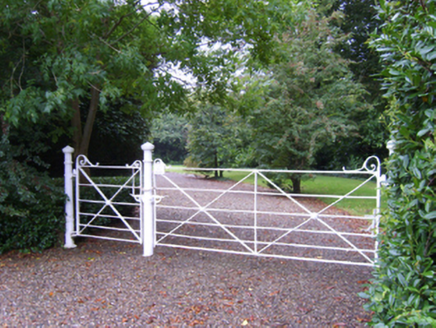Survey Data
Reg No
15703250
Rating
Regional
Categories of Special Interest
Architectural, Artistic, Historical, Social
Previous Name
Kilmallock
Original Use
Farm house
In Use As
Farm house
Date
1710 - 1715
Coordinates
303168, 132258
Date Recorded
01/10/2007
Date Updated
--/--/--
Description
Detached four-bay two-storey double-pile farmhouse, built 1714, on a rectangular plan originally four-bay two-storey single-pile. "Improved", pre-1903, producing present composition. Occupied, 1911. Renovated, 1965. Sold, 1970. For sale, 2010. Pitched (east) or hipped (west) double-pile (M-profile) slate roof with clay ridge tiles, rendered central chimney stack having stringcourse below chamfered capping supporting yellow terracotta tapered pots, and cast-iron rainwater goods on rendered eaves retaining cast-iron downpipes. Part creeper- or ivy-covered replacement fine roughcast walls on rendered plinth with Irish battlemented engaged turrets to corners centred on Irish battlemented engaged turret. Square-headed window openings with cut-granite sills, and concealed dressings framing two-over-two (ground floor) or one-over-one (first floor) timber sash windows having part exposed sash boxes. Set in landscaped grounds with cast-iron colonette piers to perimeter having conical capping supporting wrought iron-detailed "farm gate".
Appraisal
A farmhouse representing an important component of the early eighteenth-century domestic built heritage of County Wexford with the architectural value of the composition, '[a] handsome residence [in] nice pleasure grounds [with] well laid-out parterres' (Lacy 1863, 460), suggested by such attributes as the compact rectilinear plan form; the slight diminishing in scale of the openings on each floor producing a feint graduated visual impression; and the Irish battlements embellishing a high pitched roofline: meanwhile, aspects of the composition clearly illustrate the continued development or "improvement" of the farmhouse in the late nineteenth century. Having been well maintained, the elementary form and massing survive intact together with substantial quantities of the original fabric, both to the exterior and to the interior where contemporary joinery; restrained chimneypieces; and decorative plasterwork enrichments, all highlight the artistic potential of the composition. Furthermore, adjacent outbuildings (extant 1903) continue to contribute positively to the group and setting values of a self-contained ensemble having historic connections with the Peare family including Robert Peare (d. 1761; cf. 15703249); Robert Henry Peare (d. 1877; Lewis 1837 II, 173); Humphreys Francis Peare (d. 1888), 'late of Kilmallock County Wexford' (Calendars of Wills and Administrations 1888, 586); and Robert Henry Hawtrey Peare JP (----), 'Gentleman Farmer' (NA 1911).

